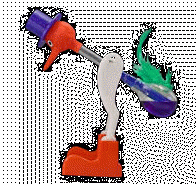|
Lesson |
Learning Outcomes |
Notes |
|
1 - Electrostatics |
-
Know that there are two types of
electrical charges
-
Know that negative charges are small and
light, and that charges can be transferred by friction.
-
Be able to describe and explain processes
involving the transfer and interaction of charges, using
correct technical language.
|
|
|
2 - Current & p.d. I |
-
Know that current is the
rate of flow of
electrons
-
Know that voltage
is the energy given to these electrons.
-
Be able to select and use the equation I = Q
÷ t to solve problems involving the
flow of charge in a circuit.
|
|
|
3 -
Current & p.d. II |
-
How to connect an ammeter into a circuit
to measure electric current.
-
How to connect a voltmeter into a circuit
to measure voltage.
-
Be able to build a simple circuit and
measure voltage and current.
-
|
Students need to know that voltmeters go
in parallel, ammeters in series. |
|
4 - Kirchoff's Current Law |
|
|
|
4 - Resistance
|
-
Understand the relationship
between current, voltage and resistance.
-
Select and use the equation:
Resistance =
Voltage ÷ current
|
|
|
5 and 6
IV graphs
|
|
Bulb and resistor can be done using one,
two or three cells and plotting a graph with three points (not
brilliant, but makes the point well enough). The diode can be done as a
demo, or by using an LED with a 100ohm resistor in series. Use a
rheostat to vary the voltage from 0-3V. The current is small, but just
about readable using the standard grey ammeters. |
|
7 - Kirchoff's Law |
|
|
|
7 and 8
Mains Electricity |
-
Describe the colours and purpose of Live,
Neutral and Earth wires.
-
Understand why insulation is important
for mains voltage.
-
Use the equation
Current = Power/Voltage to calculate the correct fuse.
|
Plugs for wiring - work in groups of two.
One person takes plug apart, the other rewires it. Check that each plug
is correctly wired before it goes back into the bag. Pupils can colour
and label diagrams while their partner is working on the plug.
Safety - ensure that plugs cannot be plugged in
(rivet through earth pin) and turn off room supply. |
|
9 and 10
Fuses and circuit breakers
Extended
writing opportunity |
-
Explain how the earth lead and fuse work together to
protect against electric shocks.
-
Compare MCBs and RCDs to fuses.
-
Discuss how ideas about risk and
cost are used to decide the mains voltage for a country.
|
Dangerous kettle man demo works on about
7V DC - get pupils to watch fuse wire and ammeter (do it twice) then
write their own explanation of what is happening using key idea that the
body has a high resistance so the current that flows to earth is too
small to blow the fuse, whereas the earth wire provides a low resistance
path to earth so the current is high. Mention double insulated - plastic
body - needs no earth wire. Extended writing
opportunity |
|
|
-
Revision lesson
-
Test
-
Go over test
|
Revision quiz 1
Revision quiz 2
Student checklist |

